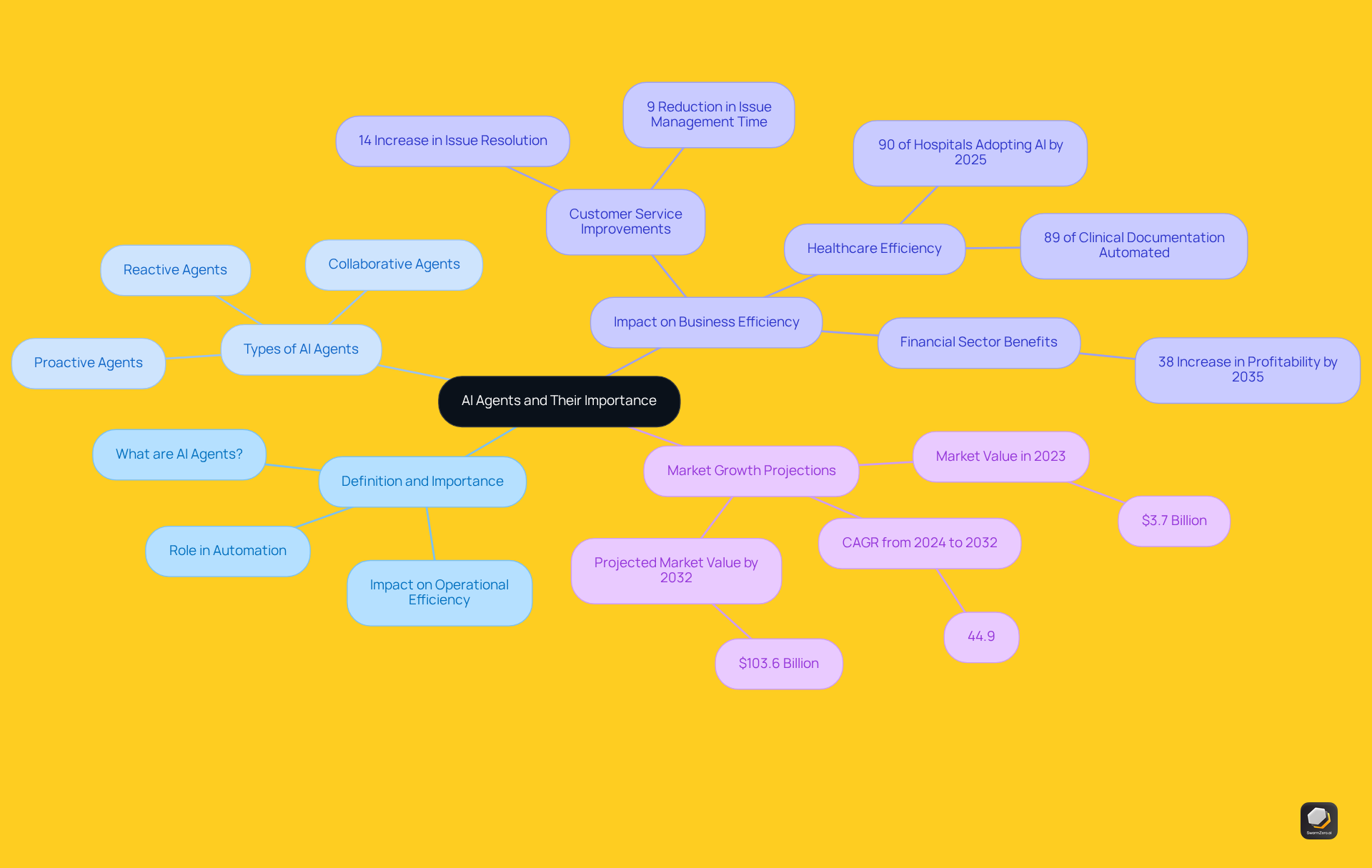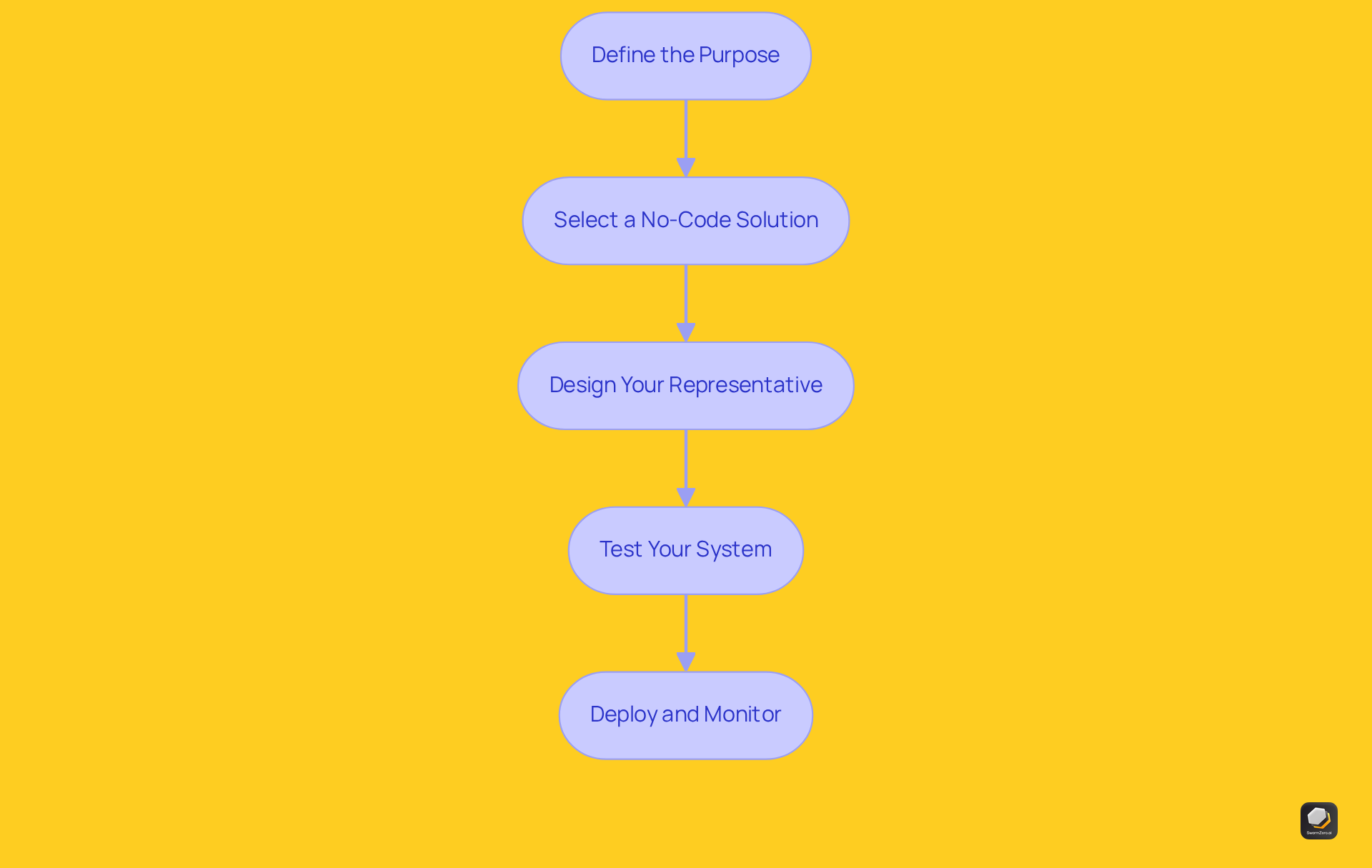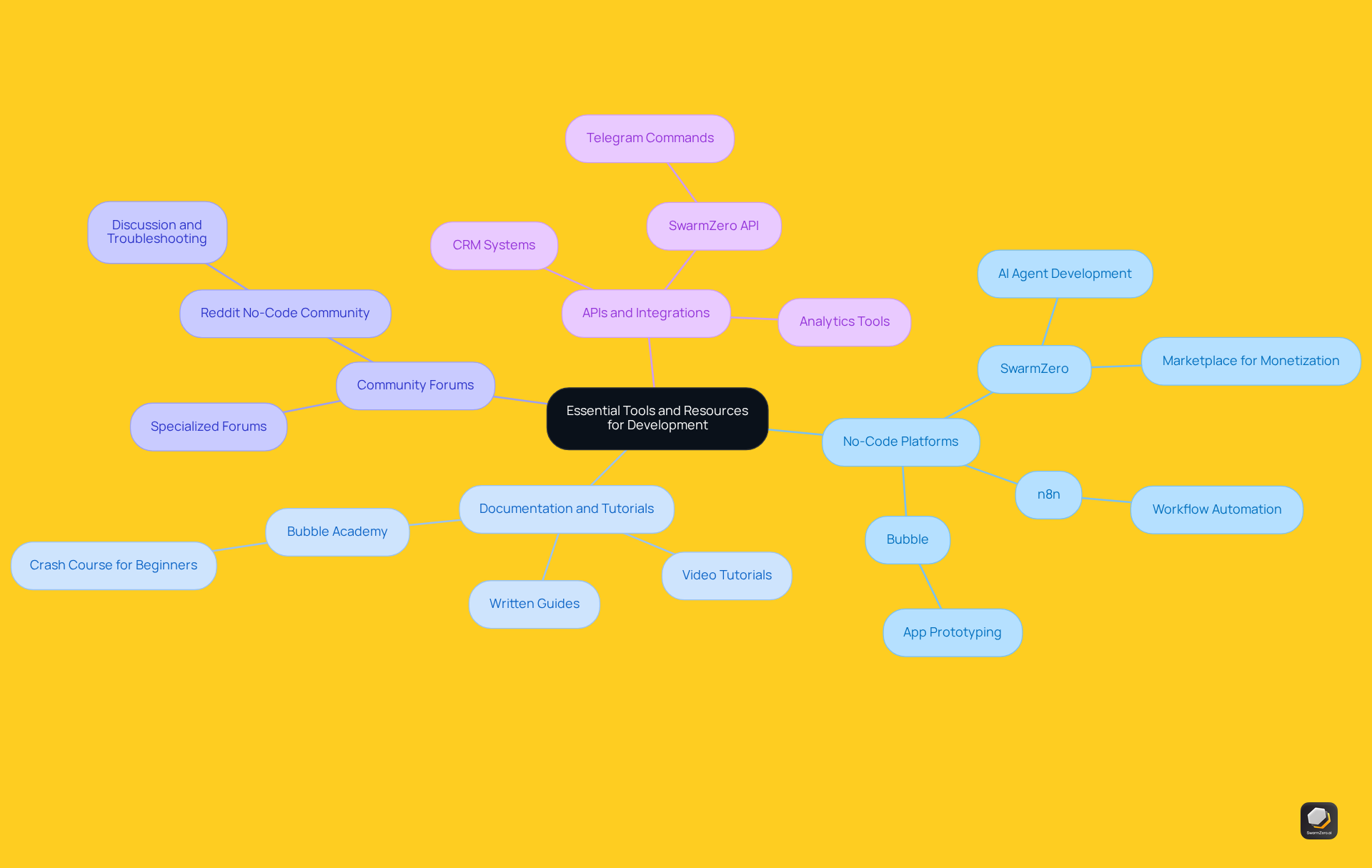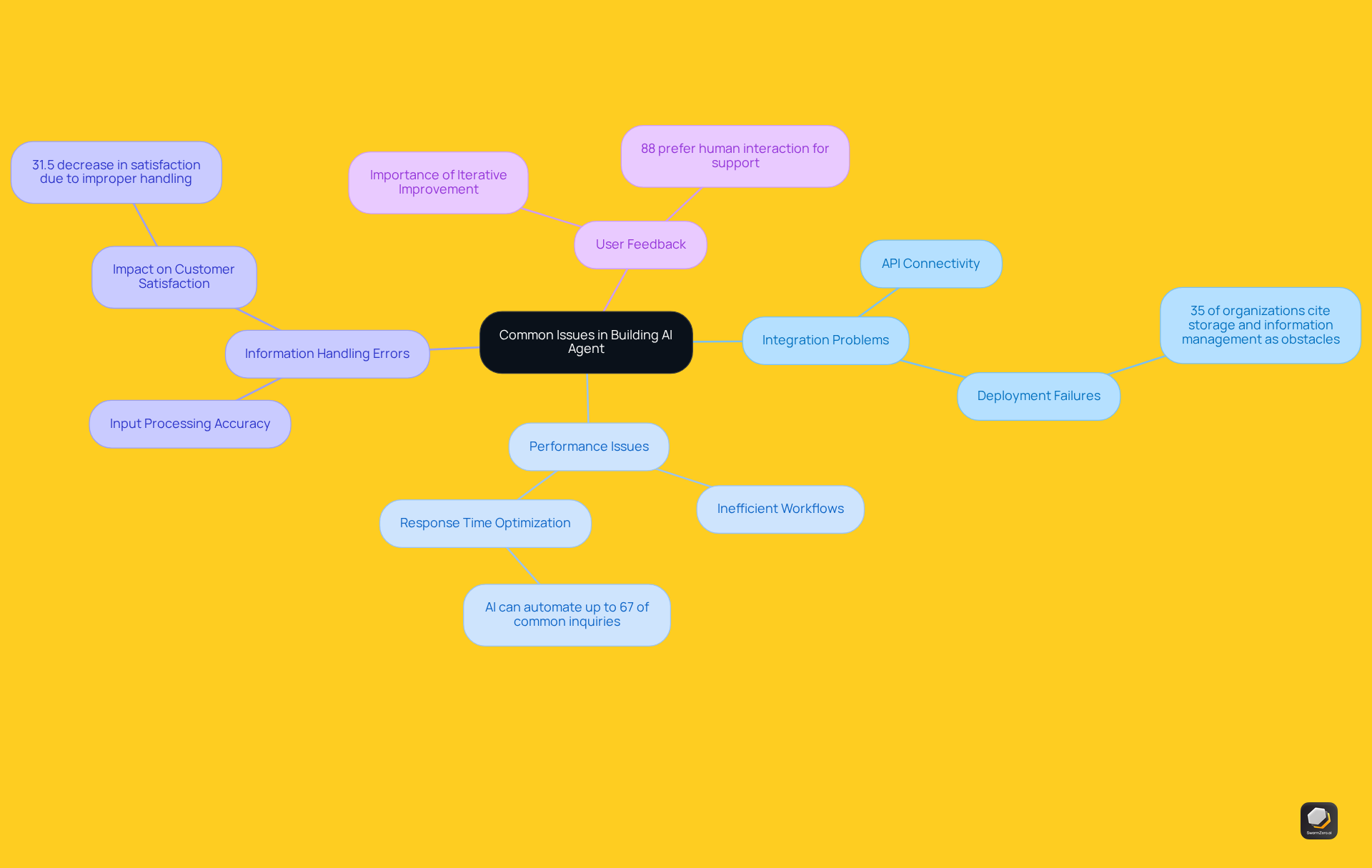4 Steps on How to Build an AI Agent No Code
Learn how to build an AI agent no code with step-by-step guidance and essential resources.

Key Highlights:
- AI agents are advanced systems that perform tasks autonomously, improving operational efficiency for businesses.
- Companies using AI in customer service report a 14% increase in issue resolution and a 9% reduction in management time.
- Types of AI agents include reactive, proactive, and collaborative, each serving different functions.
- 80% of marketers say AI tools have exceeded ROI expectations, highlighting AI's transformative potential.
- The AI market was valued at $3.7 billion in 2023 and is projected to reach $103.6 billion by 2032, growing at a CAGR of 44.9%.
- The no-code movement is growing, with 50% of small enterprises using no-code solutions for development.
- Key steps to build an AI agent include defining its purpose, selecting a no-code platform, designing workflows, testing, and monitoring performance.
- Common issues in AI development include integration problems, performance inefficiencies, and user feedback handling.
- Gathering resources such as no-code platforms, documentation, community forums, and APIs is essential for effective AI development.
Introduction
AI agents are revolutionising business operations, automating tasks and enhancing decision-making with remarkable efficiency. As companies increasingly recognise the potential of these intelligent systems, a no-code approach to building AI agents is emerging as a game-changer. This approach allows even those without technical expertise to harness the power of artificial intelligence.
However, with a multitude of platforms and tools available, navigating the complexities of creating a functional AI agent without writing a single line of code can be daunting. This guide provides a clear, step-by-step roadmap to demystify the process, enabling anyone to develop their own AI agent and unlock the myriad benefits it offers.
Understand AI Agents and Their Importance
AI programmes represent advanced software systems that autonomously perform tasks on behalf of users. They analyse data, make informed decisions, and interact with other systems to achieve specific objectives. The integration of AI systems is vital for companies, as they automate repetitive tasks, enhance decision-making, and significantly improve operational efficiency. For instance, organisations utilising AI systems in customer service have reported a 14% increase in issue resolution per hour and a 9% reduction in time spent managing issues. This not only leads to substantial cost savings but also enables teams to focus on strategic initiatives instead of mundane tasks.
Understanding the various types of AI agents—reactive, proactive, and collaborative—provides further clarity on their diverse applications across industries. Reactive agents respond to specific stimuli, while proactive agents anticipate needs and act accordingly. Collaborative entities work alongside humans, enhancing productivity through teamwork. As companies increasingly adopt AI systems, 80% of marketers report that AI tools have exceeded their return on investment expectations, underscoring the transformative potential of these technologies in driving efficiency and growth.
The framework plays a critical role in this landscape, offering a comprehensive AI marketplace for developing, monetising, and automating business solutions. By utilising the Tavily API, which enhances web search capabilities through advanced data retrieval and processing techniques, SwarmZero empowers organisations to leverage AI-powered processing for more effective data analytics. Moreover, the AI sector was valued at $3.7 billion in 2023 and is projected to reach $103.6 billion by 2032, expanding at a CAGR of 44.9% from 2024 to 2032. This highlights the transformative potential of these technologies in enhancing efficiency and growth across various sectors, including healthcare, where 90% of hospitals globally are expected to adopt AI tools by 2025.

Follow Step-by-Step Instructions to Build Your AI Agent
-
Define the Purpose: Begin by pinpointing the specific tasks your AI system will manage. This could include automating customer inquiries, generating personalised sales proposals, or creating reports. Clearly defining the purpose is crucial for effective deployment.
-
Select a No-Code Solution: Opt for a no-code solution such as SwarmZero, n8n, or Bubble that aligns with your requirements. These systems provide user-friendly interfaces that show how to build an ai agent no code. Notably, 50% of small enterprises have already embraced no-code development solutions, underscoring their increasing relevance in the industry.
-
Design Your Representative: Utilise the tools provided by your chosen platform to construct your representative. This process generally includes setting up workflows, defining triggers, and detailing the actions your representative should perform. The no-code movement is projected to reach a market value of $21.2 billion by the end of 2024, illustrating the increasing accessibility of app development, including how to build an ai agent no code.
-
Test Your System: Prior to deployment, conduct thorough testing of your AI system to ensure it operates as intended. Gather feedback and make necessary adjustments based on testing outcomes. Companies using no-code tools report an average cost reduction of 60% in app development budgets, underscoring the efficiency of this approach.
-
Deploy and Monitor: Once you are satisfied with your programme's performance, proceed with deployment. Continuously monitor its functionality and make improvements as needed to enhance its effectiveness. By 2025, 85% of businesses are anticipated to embrace AI systems, making continuous improvement crucial for sustaining competitive edge.

Gather Essential Tools and Resources for Development
To build your AI agent effectively, gather the following tools and resources:
-
No-Code Platforms: Explore platforms like SwarmZero, n8n, and Bubble, which empower users to create AI agents without any coding knowledge. This platform, in particular, features an intuitive Builder that streamlines the development of customised AI solutions for various tasks, such as automating content creation and producing personalised sales proposals. Furthermore, the platform supports the Tavily API, enhancing your agent's web search capabilities through AI-powered processing.
-
Documentation and Tutorials: Leverage a wealth of online resources, including video tutorials and written guides, to familiarise yourself with the features of your selected system. Numerous services, like SwarmZero, provide extensive documentation that significantly reduces the learning curve for new users.
-
Community Forums: Engage with vibrant communities on platforms like Reddit or specialised forums dedicated to no-code development. These forums are invaluable for asking questions, sharing experiences, and gaining insights from other developers who have successfully created AI systems. For instance, the no-code community on Reddit serves as an excellent starting point, where you can discuss strategies and troubleshoot issues.
-
APIs and Integrations: Understand the APIs that your AI assistant may need to engage with, such as CRM systems or analytics tools. Familiarity with these integrations can enhance your representative's capabilities, enabling it to retrieve information and automate processes efficiently. As the no-code market continues to expand, with projections indicating it will reach USD 68.05 billion by 2028, the significance of seamless integrations cannot be overstated. With SwarmZero's capabilities, you can utilise the bot's Telegram commands, such as
/startto initialise the bot or/chainsto list supported blockchains, facilitating analysis of market data and trading activities.
By utilising these resources, you can discover how to build an AI agent no code, which will streamline the development of your AI system, ensuring it meets your specific needs while maximising efficiency and productivity.

Troubleshoot Common Issues When Building Your AI Agent
When considering how to build an AI agent no code, several common issues may arise that can hinder its performance and integration.
-
Integration Problems: It is crucial to ensure that your AI agent connects seamlessly with the necessary APIs. Double-check API keys and permissions; integration issues are a leading cause of deployment failures. In fact, approximately 35% of organisations cite storage and information management as primary obstacles to AI adoption, underscoring the importance of robust integration strategies.
-
Performance Issues: If your representative is slow or unresponsive, it may stem from inefficient workflows. Review and optimise these workflows, as AI-powered systems can automate up to 67% of common inquiries and recurring tasks. Performance optimization can lead to significant enhancements in response times and user satisfaction.
-
Information Handling Errors: Ensure your representative accurately processes and interprets input information. Verify formats and types to avoid errors, as improper handling can result in a 31.5% decrease in customer satisfaction scores. Implementing rigorous data validation processes is essential for maintaining the integrity of your AI system's operations.
-
User Feedback: After deployment, actively gather user feedback to pinpoint areas for improvement. This iterative process is vital, as 88% of individuals still prefer speaking with a human when seeking support. Utilise this feedback to refine your agent's design and functionality, ensuring it meets user expectations and enhances the overall experience.

Conclusion
AI agents are revolutionising business operations by automating tasks and enhancing decision-making capabilities. The no-code approach to building these intelligent systems empowers individuals and organisations to leverage AI technology without needing technical expertise. This guide outlines a comprehensive, step-by-step process, making it accessible for anyone to create their own AI agent and reap the associated benefits.
Key insights include:
- The necessity of clearly defining the purpose of the AI agent
- Selecting suitable no-code platforms
- Designing effective workflows
- Conducting thorough testing before deployment
Additionally, gathering essential tools and resources, such as documentation, community support, and integration knowledge, is vital for successful AI agent development. Addressing common issues like integration problems and performance inefficiencies further ensures that the AI agent operates optimally, enhancing user satisfaction and operational efficiency.
As businesses increasingly embrace AI technologies, the significance of developing no-code AI agents cannot be overstated. By proactively building and refining these systems, organisations can streamline operations, reduce costs, and concentrate on strategic initiatives that drive growth and innovation. Embracing this no-code movement not only opens doors to automation but also positions companies at the forefront of technological advancement.
Frequently Asked Questions
What are AI agents and what do they do?
AI agents are advanced software systems that autonomously perform tasks for users. They analyse data, make informed decisions, and interact with other systems to achieve specific objectives.
Why is the integration of AI systems important for companies?
The integration of AI systems is crucial as they automate repetitive tasks, enhance decision-making, and significantly improve operational efficiency, allowing teams to focus on strategic initiatives.
What improvements have organisations seen by using AI in customer service?
Organisations using AI in customer service have reported a 14% increase in issue resolution per hour and a 9% reduction in time spent managing issues.
What are the different types of AI agents?
The different types of AI agents include reactive agents, which respond to specific stimuli; proactive agents, which anticipate needs and act accordingly; and collaborative agents, which work alongside humans to enhance productivity.
How successful are AI tools in terms of return on investment for marketers?
80% of marketers report that AI tools have exceeded their return on investment expectations.
What role does the framework play in AI development and implementation?
The framework provides a comprehensive AI marketplace for developing, monetising, and automating business solutions, enhancing the overall efficiency of AI integration.
How does the Tavily API enhance AI capabilities?
The Tavily API enhances web search capabilities through advanced data retrieval and processing techniques, enabling organisations to leverage AI-powered processing for more effective data analytics.
What is the projected growth of the AI sector?
The AI sector was valued at $3.7 billion in 2023 and is projected to reach $103.6 billion by 2032, expanding at a CAGR of 44.9% from 2024 to 2032.
In which sectors is AI expected to have a significant impact?
AI is expected to significantly impact various sectors, including healthcare, where 90% of hospitals globally are anticipated to adopt AI tools by 2025.
List of Sources
- Understand AI Agents and Their Importance
- AI Agents in 2025: Expectations vs. Reality | IBM (https://ibm.com/think/insights/ai-agents-2025-expectations-vs-reality)
- AI Agent Statistics for 2025: Adoption, ROI, Performance & More (https://plivo.com/blog/ai-agents-top-statistics)
- 100+ AI Agent Statistics Every Tech Enthusiast Should Know 2024 (https://blog.getodin.ai/100-ai-agent-statistics-every-tech-enthusiast-should-know-2024)
- 30+ Powerful AI Agents Statistics In 2025: Adoption & Insights (https://warmly.ai/p/blog/ai-agents-statistics)
- IBM Study: Businesses View AI Agents as Essential, Not Just Experimental (https://newsroom.ibm.com/2025-06-10-IBM-Study-Businesses-View-AI-Agents-as-Essential,-Not-Just-Experimental)
- Follow Step-by-Step Instructions to Build Your AI Agent
- Microsoft Build 2025: The age of AI agents and building the open agentic web - The Official Microsoft Blog (https://blogs.microsoft.com/blog/2025/05/19/microsoft-build-2025-the-age-of-ai-agents-and-building-the-open-agentic-web)
- AI Agents Statistics: Usage And Market Insights (https://litslink.com/blog/ai-agent-statistics)
- Responsive Spring 2025 Release Puts Custom Agents in Customers’ Hands, Accelerating Impact and Reach of AI (https://businesswire.com/news/home/20250519805303/en/Responsive-Spring-2025-Release-Puts-Custom-Agents-in-Customers-Hands-Accelerating-Impact-and-Reach-of-AI)
- No-Code App Builder Statistics: Usage Statistics (2024) (https://appstylo.com/no-code-app-builder-statistics)
- 120+ No-Code/Low-Code Statistics and Trends That You Need to Know in 2025 (https://userguiding.com/blog/no-code-low-code-statistics)
- Gather Essential Tools and Resources for Development
- The 8 best no-code app builders in 2025 | Zapier (https://zapier.com/blog/best-no-code-app-builder)
- 120+ No-Code/Low-Code Statistics and Trends That You Need to Know in 2025 (https://userguiding.com/blog/no-code-low-code-statistics)
- Accenture Expands AI Refinery and Launches New Industry Agent Solutions to Accelerate Agentic AI Adoption (https://newsroom.accenture.com/news/2025/accenture-expands-ai-refinery-and-launches-new-industry-agent-solutions-to-accelerate-agentic-ai-adoption)
- No Code Statistics - Market Growth & Predictions (Updated 2025) (https://codeconductor.ai/blog/no-code-statistics)
- 75+ Low-code Statistics and Facts to Know (https://esparkinfo.com/blog/low-code-statistics)
- Troubleshoot Common Issues When Building Your AI Agent
- AI Agent Statistics for 2025: Adoption, ROI, Performance & More (https://plivo.com/blog/ai-agents-top-statistics)
- 10+ Crucial AI Customer Service Statistics ([wcyear]) (https://tidio.com/blog/ai-customer-service-statistics)
- Gartner Predicts Agentic AI Will Autonomously Resolve 80% of Common Customer Service Issues Without Human Intervention by 2029 (https://gartner.com/en/newsroom/press-releases/2025-03-05-gartner-predicts-agentic-ai-will-autonomously-resolve-80-percent-of-common-customer-service-issues-without-human-intervention-by-20290)
- AI Agents Statistics: Usage And Market Insights (https://litslink.com/blog/ai-agent-statistics)
- AI in Customer Service Statistics [January 2025] (https://masterofcode.com/blog/ai-in-customer-service-statistics)




